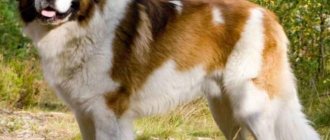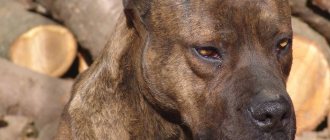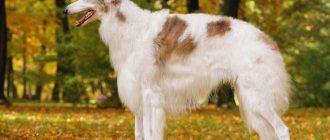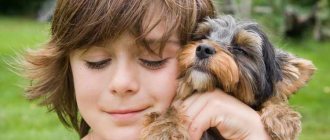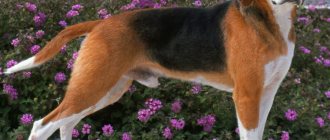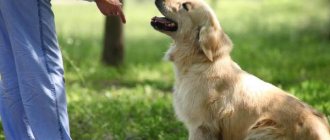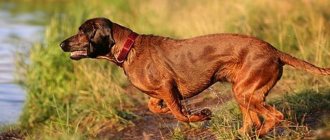a brief description of
- Other names: Sicilian Hound, Cirneco dell'Etna, Sicilian Greyhound, Sicilian Greyhound, Sicilian.
- Height: 46.0-50.0 cm.
- Weight: 10-12 kg.
- Color: red, even, rich. Let's say white and white with red tan. All shades of fawn and all shades of ocher are allowed.
- Coat: short, no longer than 3.0 cm, smooth, lying close to the body.
- Life expectancy: 12-15 years.
- Advantages of the breed: easy to train, unpretentious dogs. They have an affectionate and affectionate character. Their temperaments are typical hunters. The family has cheerful, loving and very active dogs, right up to old age.
- Difficulties: hard to tolerate cold, and especially dampness. Dogs need to be warmed in winter. The animal's claws require careful attention and should be trimmed promptly.
- Price: $950.
Cirneco del Etna - living companions of the departed pharaohs
The proud Silician dog breed has ancient roots going back 2.5 thousand years. On ancient coins of the period III-V centuries BC. and mosaics of the era depict the profile of Cirneco. Through genetic analysis, the relationship between modern individuals and pharaoh dogs has been proven.
Purpose of the breed
There are two unofficial modern varieties of the Sicilian Greyhound breed:
- southern type;
- type of northern Cirneco dell'Etna.
Both types differ in body proportions and different lengths of limbs. But this factor was not reflected in the description of the breed standard adopted by the FCI. Leg length no small importance only for dogs working in the Sicilian landscape - mountainous in the north and flat rocky in the south of the country and at the foot of a volcano. Greyhounds are still used for their intended purpose. They participate in traditional rabbit hunting.
Over the past fifty years, animals have been bred exclusively for sporting competitions. Also, field trials are often held for breeding dogs, where the Cirneco dell'Etna can show itself in all its glory.
The third purpose of the modern Sicilian is a companion dog. Obedient, intelligent, extremely sensual dogs often become prize-winners in dog shows held around the world. Sicilian greyhounds also take part in coursing competitions, or simulated hare-catching races, and agility.
Advantages and disadvantages
Cirneco is a dog breed that has a fairly extensive list of advantageous features, thanks to which it is so valued in its homeland:
- unpretentious pets;
- curious and easy to learn;
- have an affectionate and affectionate character;
- typical hunter's temper;
- active and inquisitive until old age, so they need to devote a lot of time.
Another significant advantage is that dogs do not have an undercoat, therefore, the animals have no odor and the likelihood of developing an allergic reaction in household members is very small.
Despite a number of advantages, there are also disadvantages:
- hind toes dewclaws;
- short dewlap and neck;
- short muzzle;
- divergence of the muzzle and skull.
Dogs can be touchy at times. If the owner has offended his pet, the latter may stop obeying and carry out even the most primitive commands.
History of the breed
The Cirneco dell'Etna is a very ancient breed, living in Sicily for hundreds or thousands of years. It is similar to other breeds native to the Mediterranean: the Pharaoh Hound of Malta, the Ibicenco Podenco and the Canario Podenco.
These breeds are distinguished by their primitive appearance, all native to the Mediterranean islands and specialized in hunting rabbits.
It is believed that Cirneco del Etna comes from the Middle East. Most linguists believe that the word Cirneko comes from the Greek “Kyrenaikos”, the ancient name of the Syrian city of Shahhat.
Cyrene was the oldest and most influential Greek colony in Eastern Libya and was so important that the entire region is still called Cyrenaica. It is believed that at first the dogs were called Cane Cirenaico - a dog from Cyrenaica.
This indicates that dogs came to Sicily from North Africa, along with Greek merchants.
The first written use of the word Cirneco appears in a Sicilian law from 1533. He limited hunting with these dogs, as they caused great damage to the prey.
There's just one big problem with the evidence base for this theory. Cyrene was founded later than these dogs appeared. Coins dating back to the 5th century BC show dogs almost identical to the modern Cirneco dell'Etna.
It is likely that they came to Sicily earlier and were then mistakenly associated with this city, but it may be that they are an indigenous breed. Recent genetic studies have revealed that the Pharaoh Hound and the Ibicenco Podenco are not so closely related.
Moreover, these greyhounds did not descend from one ancestor, but developed independently of each other. It is possible that Cirneco dell'Etna emerged through natural selection, but also that the genetic tests are flawed.
We will never know exactly how it appeared, but the fact that it was highly valued by local residents is a fact. As mentioned, these dogs were regularly depicted on coins issued between the 3rd and 5th centuries BC. e.
On one side they depict the god Adranos, the Sicilian personification of Mount Etna, and on the other a dog. This means that 2500 years ago they were associated with a volcano, which gave the rock its modern name.
Legend has it that Dionysus, the god of wine and fun, founded a temple on the slope of Etna around 400 BC, near the city of Adrano. Dogs were bred in the temple to serve as guards within the temple, and at one point there were about 1,000 of them. The dogs had a divine ability to identify thieves and non-believers, whom they immediately attacked. They found lost pilgrims and escorted them to the temple.
According to legend, Cirneco was especially disposed towards drunken pilgrims, since most of the holidays dedicated to this god took place with copious libations.
The breed remained a native hunting breed for hundreds of years, even after its religious significance disappeared with the advent of Christianity. Images of these dogs can be found on many Roman artifacts.
They were distributed throughout Sicily, but especially in the region of Mount Etna. The main object of hunting for them was rabbits, although they could hunt other animals.
The Romans began a policy of deliberately cutting down forests to make room for crops, which they continued after them.
Large mammals disappeared as a result of this; the only animals available for hunting were rabbits and foxes. Hunting rabbits was an extremely important activity for Sicilian peasants, since, on the one hand, they destroyed crops, and on the other, they served as an important source of protein.
If throughout Europe keeping dogs was the lot of the aristocracy, then in Sicily they were kept by peasants. They were an important part of their lives, but they fell on hard times at the beginning of the 20th century.
Technology and urbanization meant that the need for dogs decreased and few could afford them. Moreover, besides the island, Cirneco dell'Etna was not popular anywhere, even in mainland Italy. In 1932, Dr. Maurizio Migneco, a veterinarian from Andrano, wrote an article for the magazine “Italian Hunter” (Cacciatore Italiano), where he described the deplorable state of the ancient breed.
Several very influential Sicilians joined forces to save the breed. They were joined by Baroness Agata Paterno Castelo, better known as Donna Agata.
She will devote the next 26 years of her life to this breed, study its history, and find the best representatives. She will collect these representatives in her nursery and begin methodical breeding work.
When Cirneco is restored, she will turn to the famous zoologist, Professor Giuseppe Solano. Professor Solano would study canine anatomy, behavior and publish the first breed standard in 1938. The Italian Kennel Club recognizes it instantly, since the breed is clearly older than most native Italian dogs.
In 1951, the first club for fans of this breed was founded in Catania. The Fédération Cynologique Internationale recognized the breed in 1989, which generated interest in it outside of Italy.
Unfortunately, she is still little known outside her homeland, although she has her fans in Russia.
Description of the breed
The Cirneco dell'Etna breed standard was adopted by the FCI in 1989 under number 199.
Table: excerpts from the FCI breed standard dated 03.11.1999
| Standard item | Description |
| Origin | Italy |
| Date of publication of the official standard | 27.11.1989 |
| Usage | A hunting dog used primarily for chasing rabbits |
| FCI classification | Belongs to group 5 “Spitz and dogs of primitive type”, section 7 “Primitive hunting breeds” |
| General form | A dog of a primitive type, medium size, thin but at the same time strong build |
| Important proportions | One of the important features is the so-called square format, that is, the height at the withers is approximately equal to the length of the body |
| Character | Good temperament, affectionate dog, although hunting |
| Head | Features of the skull:
Features of the transition from the forehead to the muzzle - the transition is well marked, the angle between the back of the nose and the skull is approximately 140 degrees. Features of the front part:
|
| Neck | Well curved, skin tight, no folds |
| Frame |
|
| Tail | Low set, saber-shaped, thick throughout, with short hair |
| Limbs | The main requirements are that the limbs, both front and rear, must be straight and parallel; there are some relationships fixed in the standard regarding inclination angles and proportions. The claws should be flesh-colored, but not black. |
| Movements | Gallop, trot |
| Leather | Thin, well-stretched skin, the color matches the coat color. The mucous membranes and skin of the nose should not have black spots, and there should be no areas without pigment. |
| Coat |
|
| Dimensions, weight |
|
| Flaws | A defect is any deviation from the standards described above. |
| Disqualifying faults |
|
Breed characteristics
Male height at withers: 46-50 cm,
Male weight: 10-12 kg.
Bitch's height at the withers: 42-46 cm,
Bitch weight: 8-10 kg.
Color: fawn (dark or light), sable, isabella, red. If the color is red, white markings are acceptable. White color with reddish spots is also acceptable.
Additional signs:
- The nose is triangular, matching in color with the coat, usually beige or hazelnut.
- The eyes are oval and small, ocher, amber or even gray, but not brown.
- The Cirneco dell'Etna has an elegant silhouette with slender legs.
Origin story
The first information about the existence of elegant dogs with the musical-sounding name Cirneco dell'Etna was recorded as a result of archaeological excavations in the area at the foot of the Sicilian volcano Etna. Hence the prefix to the name of the breed.
According to scientists, the breed dates back at least two and a half thousand years , and belongs to the aboriginal dogs of the island of Sicily. According to recent research, which was based on genetic analysis, animals in Sicily appeared thanks to the ancient Egyptians, who developed the surrounding territories.
Scientists have noticed that the images of animals on the sarcophagi and tombs of the ancient Egyptian pharaohs are very similar to the modern phenotype of these dogs - beautiful and elegant with long, gracefully upward-pointing ears.
Even the Egyptian god of the underworld, Anubis, has similarities with the features of the pointy-eared Sicilian greyhound. Therefore, we can safely make the assumption that the age of the breed is much older than official information is presented to us.
Other Italian dogs that are close to this phenotype are the Pharaoh Hound and the Ibicenco Podenco, which are just as elegant and evenly colored, but differ from the Cirneco dell’Etna in a much larger size. It can be assumed that all of the above Italian dogs had common ancestors.
Education and training
The generally accepted scheme developed for service dogs is not suitable for raising and training the Cirneco del Etna. Cirneca cannot be forced to follow commands, and they do not tolerate raised voices or physical punishment. They will fulfill requests only if they themselves are interested in it.
Teaching any command should be based on the fact that the dog is interested in performing it. Reinforcement can be a treat, praise, or a toy.
Character
If there is no such opportunity, then he suffers greatly from loneliness. Although there is no reliable information about her attitude towards children, it is believed that she treats her very well, especially if she grew up with them.
She has no aggression towards strangers either; they are very friendly and happy to meet new people. They like to express their feelings by jumping and trying to lick; if this is unpleasant for you, you can correct the behavior by training. It is logical that a dog with such a character is not suitable for the role of a guard. They get along well with other dogs, moreover, they prefer their company, especially if it is another Cirneco del Etna. Like other dogs, without proper socialization they can be fearful or aggressive, but such cases are rather the exception.
But they do not find a common language with other animals. The Sicilian Greyhound is designed to hunt small animals, has successfully hunted them for thousands of years, and has an incredibly strong hunting instinct. These dogs chase and kill everything in their power, so a walk can end in disaster. With proper training they are capable of living with a domestic cat, but some never accept them.
The Cirneco dell'Etna is one of the most trainable, if not the most trainable, of the Mediterranean greyhounds. Representatives of the breed performing in agility and obedience perform very well.
They are very intelligent and learn quickly, but are sensitive to training methods. Rudeness and harsh behavior are more likely to scare them away, but a kind word and delicacy will delight them. Like other greyhounds, they do not respond well to commands when chasing an animal. But, compared to others, they are not yet hopeless and are able to stop.
When keeping it in the yard, you need to ensure its complete safety. These dogs are able to crawl into the smallest gap, jump high and dig the ground very well.
Temperament
The Cirneco dell'Etna has an extremely strong and independent character . At the same time, they easily make contact, show friendliness and are attached to their owners. They have a stable psyche and a need for a variety of activities.
This is an exclusively domestic dog , albeit a very energetic one. They like to alternate between playing and sleeping under a warm blanket.
They become attached to all family members, although one will be singled out. However, this point is not expressed as strongly among them as among the Salukis. They are jealous of their territory, but they treat family friends warmly.
This breed is not prone to unnecessary fuss and loud barking . Although they are small in size, they are not toy dogs.
Psyche
Breed experts say that Cirneco dogs are good companions for walking and sports, hunters and even, to some extent, guards. Cirnecos are smart, their psyche is stable, and despite their small size, they are fearless and loyal.
Cirnecos need additional socialization. Natural dogs are fun-loving by nature and in some ways wild and impulsive. They are one of those who, upon meeting, energetically jump on the owner, trying to lick his face. They do not bark much, but they carefully monitor their surroundings. In a busy area it is recommended to keep him on a leash. It is noted that cirnecos take a long time to mature - up to 2 years. It is recommended to socialize pets from an early age and take them with you to public places to strengthen stress resistance and cultivate goodwill towards others.
Cirneco gets along well with children, but is not a nanny dog and does not like to be cuddled too much. They will get along well with other pets if they were raised together. If other animals appear in the house during adulthood, the cirneco may have problems associated with rejection of the new member of the pack. In the house, they mistake the owner for the leader and always follow him. They even prefer to sleep in the owner’s bed - this should also be taken into account when choosing this breed.
Who is the Sicilian dog suitable for?
The Sicilian Greyhound is suitable for apartment living. But it is important that the owner leads an active lifestyle. As practice shows, the breed is ideal for athletes and hunters. The pet should not be left alone at home for an extended period of time.
Note! The dog is friendly, but with the appearance of children in the house, you should not count on its 100% obedience. Pets often become jealous, so breeders recommend holding off on purchasing a dog until your children are older.
In an apartment, the animal gets along with other pets, but on the street at any convenient time it can chase another dog or cat.
Care and maintenance
In general, a dog requires the same care as any other. Natural health and the absence of genetic diseases do not create great difficulties in maintenance.
It is recommended to take into account the southern origin of the breed and take care of a warm bed, protected from drafts. In cold weather, you will need warm clothes for your pet. Physical activity promotes a healthy lifestyle and prevents dog obesity. Her appetite is always excellent.
Short hair requires minimal grooming. Regular brushing of the dog, about once a week, is necessary to remove dead hair. Large ears need cleaning to avoid inflammation and otitis media.
the Cerneco del Etna puppy to trimming its nails from an early age, otherwise it will desperately resist.
Grinding of claws can be achieved naturally only with systematic exercise and walks in nature.
Reviews
Valery:
Our pet is only three months old, but he is a born athlete. Not once did he lag behind me on a bike ride. He always runs alongside and can keep the pace for a long time, and this is at three months! Passionately loves fruits, and most of all apples.
Lena:
This breed was created for me, with my restless character. And it’s good that I took the boy. True, I had to suffer a little with his upbringing, but now he is just a calm and surprisingly obedient dog, who will not take a step without my order.
We invite everyone who has had at least a little contact with this amazing ancient breed of dog - the Cirneco dell'Etna - to dialogue. Tell us about your experience with these animals. What are their advantages and what disadvantages could become an obstacle to purchasing a puppy of this breed. We look forward to your comments and feedback. They can be left at the bottom of the article.
Share
Leave a review
Diseases
Due to their natural origin, Cirnecos have very good health and are long-lived among dogs, living about 15 years. It is important not to ruin your health, for example, by poor nutrition.
There are some care features to maintain health:
- Cirnecos are sunny dogs, and in some regions there is little sun, which requires additional vitamin D to be added to the diet, after consulting with a veterinarian.
- Cirneco dogs are naturally accustomed to warmth, and in very cold climates with sub-zero temperatures, the use of clothing is necessary for them. But you shouldn’t be zealous - excessive care is harmful to health, with slight cold snaps dogs adapt well, and there is no need for clothing.
- Like other breeds, Cirnecos are susceptible to infectious diseases, so all necessary vaccinations must be done regularly.
Choosing a Cirneco del Etna puppy
Just 10-15 years ago, it was almost impossible to meet Cirneca in the territory of the former CIS, and the number of representatives of the breed could be counted on one’s fingers. Today, Cirneco dell'Etna still remains rare and few in number due to its specificity, but every year they attract more and more attention. This contributed to an increase in the number of livestock. Today, in most European countries there is an officially registered nursery that breeds Cirneco dell'Etna. In addition, private breeders sometimes sell puppies. Very rarely, these dogs are bred by owners “for health” or to earn money and then sell the puppies without documents, but much cheaper.
Regardless of the purpose of purchasing a Cirneca, the chosen puppy must be healthy, with the correct psyche and appearance. Of course, in appearance he is still different from an adult dog and does not fully correspond to the standard, but there are shortcomings that even a baby should not have: incorrect bite, drooping ears, curled tail, black claws or pads, very dark eyes or nose, solid brown color , the presence of black hair or dark spots on the mucous membrane. Pay attention to the conditions of keeping and feeding dogs. Properly raised babies have the correct condition, they are active and curious, with a good appetite, absolutely healthy in appearance, with clean, clear eyes and shiny coat.
Proof of belonging to the breed will be a brand and a puppy card, which is later exchanged for a pedigree. Also, future owners will have to receive a purchase and sale agreement and a veterinary passport, which contains notes on the manipulations and vaccinations performed.
How much does it cost and where can I buy it?
Dogs do not tolerate cold well, so they are not very common in Russia. However, in Moscow there is a National Breed Club where you can purchase a purebred puppy. The price of a dog ranges from 50-70 thousand rubles.
Nicknames and names
All pedigree puppies have nicknames, and their new owners assign pet names to them. Names do not appear in breeding records, and are used by the owner at the everyday level.
Popular nicknames for dogs of the Sicilian Greyhound breed are, as a rule, Italian concepts and definitions, as well as geographical names of places:
- males - Are, Lyman, Wacker, Hesper, Kato, Vaiden, Borat;
- females – Nelda, Lima, Nicey, Jassy, Verity, Brigita, Dixa, Bessie.
Sources
- https://www.moiasobaka.com/vse-o-porodah/srednie/chirneko-del-etna.html
- https://givotniymir.ru/chirneko-del-etna-sobaka-opisanie-osobennosti-uxod-i-cena-chirneko-del-etny/
- https://gafki.ru/sobaki/chirneko-del-etna.html
- https://prohvost.club/sobaki/porody-sobak/chirneko-del-etna-foto.html
- https://usatiki.ru/chirneko-del-etna/
- https://aquarium-fish-home.ru/sobaki/chirneko-del-etna-chem-zhe-znamenity-eti-sobachki-i-chto-sleduet-znat-budushhim-vladelcev-podobnogo-chuda/.html
- https://catfishes.ru/chirneko-del-etna/
[collapse]
